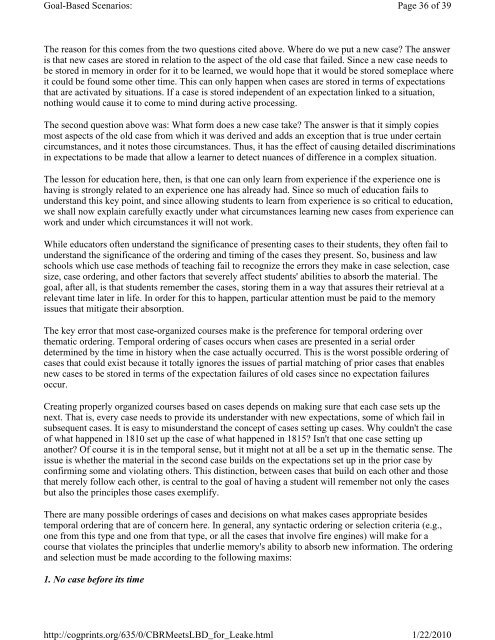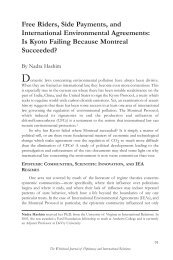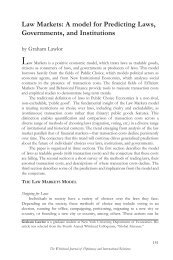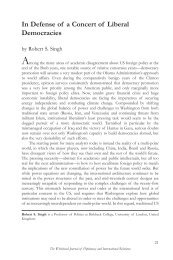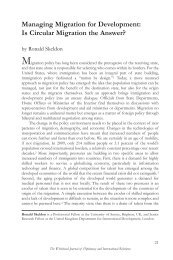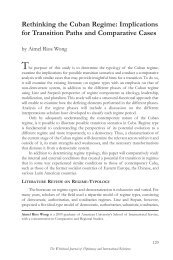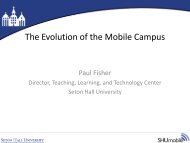Case-Based Reasoning Meets Learning by Doing
Case-Based Reasoning Meets Learning by Doing
Case-Based Reasoning Meets Learning by Doing
You also want an ePaper? Increase the reach of your titles
YUMPU automatically turns print PDFs into web optimized ePapers that Google loves.
Goal-<strong>Based</strong> Scenarios:<br />
The reason for this comes from the two questions cited above. Where do we put a new case? The answer<br />
is that new cases are stored in relation to the aspect of the old case that failed. Since a new case needs to<br />
be stored in memory in order for it to be learned, we would hope that it would be stored someplace where<br />
it could be found some other time. This can only happen when cases are stored in terms of expectations<br />
that are activated <strong>by</strong> situations. If a case is stored independent of an expectation linked to a situation,<br />
nothing would cause it to come to mind during active processing.<br />
The second question above was: What form does a new case take? The answer is that it simply copies<br />
most aspects of the old case from which it was derived and adds an exception that is true under certain<br />
circumstances, and it notes those circumstances. Thus, it has the effect of causing detailed discriminations<br />
in expectations to be made that allow a learner to detect nuances of difference in a complex situation.<br />
The lesson for education here, then, is that one can only learn from experience if the experience one is<br />
having is strongly related to an experience one has already had. Since so much of education fails to<br />
understand this key point, and since allowing students to learn from experience is so critical to education,<br />
we shall now explain carefully exactly under what circumstances learning new cases from experience can<br />
work and under which circumstances it will not work.<br />
While educators often understand the significance of presenting cases to their students, they often fail to<br />
understand the significance of the ordering and timing of the cases they present. So, business and law<br />
schools which use case methods of teaching fail to recognize the errors they make in case selection, case<br />
size, case ordering, and other factors that severely affect students' abilities to absorb the material. The<br />
goal, after all, is that students remember the cases, storing them in a way that assures their retrieval at a<br />
relevant time later in life. In order for this to happen, particular attention must be paid to the memory<br />
issues that mitigate their absorption.<br />
The key error that most case-organized courses make is the preference for temporal ordering over<br />
thematic ordering. Temporal ordering of cases occurs when cases are presented in a serial order<br />
determined <strong>by</strong> the time in history when the case actually occurred. This is the worst possible ordering of<br />
cases that could exist because it totally ignores the issues of partial matching of prior cases that enables<br />
new cases to be stored in terms of the expectation failures of old cases since no expectation failures<br />
occur.<br />
Creating properly organized courses based on cases depends on making sure that each case sets up the<br />
next. That is, every case needs to provide its understander with new expectations, some of which fail in<br />
subsequent cases. It is easy to misunderstand the concept of cases setting up cases. Why couldn't the case<br />
of what happened in 1810 set up the case of what happened in 1815? Isn't that one case setting up<br />
another? Of course it is in the temporal sense, but it might not at all be a set up in the thematic sense. The<br />
issue is whether the material in the second case builds on the expectations set up in the prior case <strong>by</strong><br />
confirming some and violating others. This distinction, between cases that build on each other and those<br />
that merely follow each other, is central to the goal of having a student will remember not only the cases<br />
but also the principles those cases exemplify.<br />
There are many possible orderings of cases and decisions on what makes cases appropriate besides<br />
temporal ordering that are of concern here. In general, any syntactic ordering or selection criteria (e.g.,<br />
one from this type and one from that type, or all the cases that involve fire engines) will make for a<br />
course that violates the principles that underlie memory's ability to absorb new information. The ordering<br />
and selection must be made according to the following maxims:<br />
1. No case before its time<br />
http://cogprints.org/635/0/CBR<strong>Meets</strong>LBD_for_Leake.html<br />
Page 36 of 39<br />
1/22/2010


